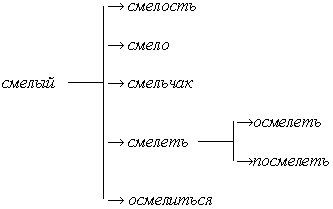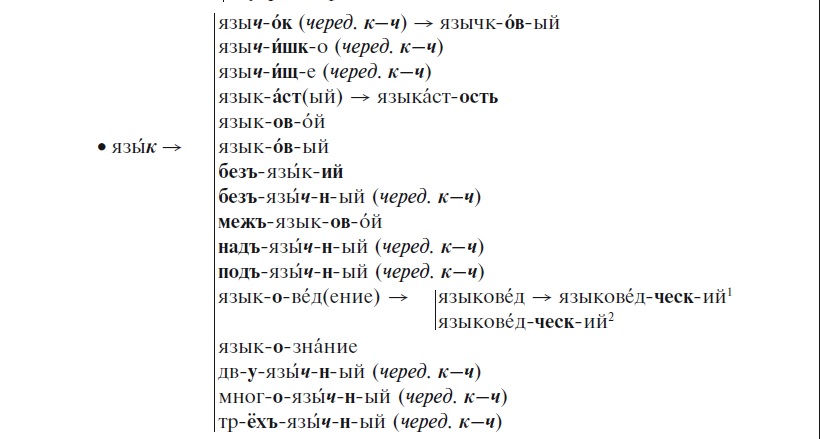а) рука, ручной, безрукий,
б) сонный, сон, сна,
в) земля, земной, земельный,
г) любить, люблю, влюблённый,
д) свет, свеча, освещение,
е) треск, трещина, треснуть.
The term morphology consists of two parts: μορφή (‘form, shape‘) and λόγος ('word, doctrine'), therefore morphology can be understood as a science that deals with forms such as cell morphology, phytomorphology, geomorphology etc.
The unit (object) of the study of linguistic morphology is a word whose form is understood to be a structure whose components are morphemes or complexes of morphemes.
In the traditional structural linguistics approach to the language the following are divided:
Elements of the lower planes consist of elements of higher planes, e.g. sentences consist of words. The plane of the building elements, which consist of words, examines the linguistic discipline morphematics (morphemics). The smallest, non-separable language units that act as building blocks of words and carry some lexical or grammatical meaning (or have a certain function) and which are repeated at least in two words or verbal forms are called morphsHowever, the smallest language unit (language element) is a phonemes that have only form, not their own meaning. Phonemes just help to differentiate the meanings of higher levels (morphs and morphemes, words). Cf. in Russian: брат – брать, том – там, дам – дым, только – столько..
The boundary between the two morphs, which are part of the same word, is called a morphemic seam (we will mark it a dash): вод-а, вод-н-ый, на-вод-н-ени-е.
A set of morphs of the same kind, which have the same lexical or grammatical significance (or the same function) and which are similar to their formal structure, are called morphemes. Morpheme is an abstract unit that is realized through one of its morphs, e.g.: ног-а, нож-к-а, без-ног-ий. Concrete morphs -ног- [ног], -нож- [нож], -ног- [ног'] are realising here morpheme with a lexical meaning „одна из двух нижних конечностей человека, а также одна из конечностей птиц, некоторых животных“. The morphs belonging to such a set (which form one morpheme) are referred to as variants of the given morpheme or as an alomorphs, in other words -ног- [ног], -нож- [нож], -ног- [ног'] are the alomorphs of the morpheme -ног- with a lexical meaning „одна из двух нижних конечностей человека, а также одна из конечностей птиц, некоторых животных“.
Morph(eme)s, from which Russian words and grammatical word forms are composed, are usually divided into root word and affixes. Root morph(eme)s (root) are the central type of morph(eme)s and carry the main lexical meaning of the whole word or grammatical form of word, that every word has a root morf(eme): вод-а, жив-ой, трав-а, мног-о, пис-а-ть, глав-н-ый, мой. Affixes are morphemes that are located in a word in front of a root morph(eme)s or after it:
Prefixes and suffixes can also be divided into:
Form-building morph(eme)s in Russian can be realized using so-called null morphs (morphological zero, mark Ø), in other words formally unrecognized morph, e.g. столØ, стол-а, стол-у or учительØ, учител-я, учител-ю, where in the nominative case the ending of a masculine gender is not expressed formally (i.e. by letter or special sound), but in other cases the ending is expressed on a formal level. If the word does not decline or conjugate, we can not speak of any null morphs at its end, e.g. in the words радио, хаки, какаду, Сочи, Брно, бордо, but in words such весело, улыбаясь we can talk about the final suffixes/postfixes: весел-о (suffix -о-), улыб-а-я-сь (postfix -сь).
The stem of a word or word form is the part of it that remains after separation of inflection (ending) or inflection with postfix -те. Morphs of other postfixes are part of a word or word form, e.g.: stem of word form пишется is пиш...ся, stem of word form чья-то is /ч'j/…то. Such stems are called intermittent in the Russian grammatical tradition.
Another branch associated with the structure of the word and its separation into morphs is word-forming (derivation) that deals with word-motivated words, i.e. words whose meaning and pronunciation are influenced in other words by the same root.
The term word-forming motivation refers to the relationship between two words with the same root, the relationship between the two words being of a dual nature:
Words with the same root that do not meet the above requirements are not found in the word-motivation relationship, e.g.: the word домик and домище, but дом – домик, дом – домище are already in relation to word-forming motivation, while one of the words pair is motivating (underlying word), the second word is motivated. Features of a motivated word are as follows:
The underlying (motivating) word in relation to the next word may be motivated, e. g.: the word учитель in the pair with the word учительница is underlying, but in relation to the word учить is motivated. Such words form derivation chains (word-forming chains): учить → учитель → учительница. The derivation chain consists of words with the same root, which are related to motivation. The first member of the derivation chain is an unmotivated word, all other members of the derivation chain are determined by their distance from the first non-motivated word (so-called motivation degree):
старый → стареть (I) → устареть (II) → устарелый (III) → устарелость (IV)
The words of the second and the higher motivation degree can be motivated by the words of the previous motivation degree, e.g.: преподавать → преподаватель → преподавательский, where the word преподавательский can be motivated both by the word преподаватель and the word преподавать.
Another important term in the field of morphematics is a family of words, which means a group of words with the same root, which is organized on the basis of its motivation. The first word (vertex) of the family of words can be an unmotivated word. A family of words can also be defined as a series of derivation chains with the same first non-motivated word.

Family of words or derivation chains can be found in Russian-language vocabulary, e.g.:

New words are created using suffixes that perform a classification function and classify words into certain paradigm, so new words created by the same suffix usually belong to the same paradigm (pattern), e.g.: учить - учи-тель, писать - писа-тель, both new words (учитель, писатель) have the same declension (учитель/писатель, без учителя/без писателя, к учителю/к писателю etc.).
Other examples of sufixation: вода - вод-н-ый, стол - стол-ик, три - три-жды.
The suffix may be null morpheme, e.g.: выходить - выход, синий - синь, задирать - задира, проезжать - проезжий.
New words are created using prefixes, e.g.: дедушка - прадедушка, огромный - преогромный, завтра - послезавтра, герой - супергерой.
New words are created by word-forming postfixes. Postfixes in Russian may be form-building (e.g.: -те in the imperative forms пишите, пойте; -ся/-сь in forms of passive voice Дом строится рабочими) and word-forming (-ся/-сь, -то, -либо, -нибудь): переписывать - переписываться (postfix - ся has a word-forming meaning of reciprocity), кто-то / что-либо / где-нибудь (postfixes -то, -либо, -нибудь have the word-forming meaning of uncertainty).
Prefixes and postfixes, unlike suffixes, attach to the whole word, not to the root, so the words created by prefixing or postfixing belong to the same word type and paradigm as an underlying word.
E.g.: больной (больной ребёнок) – больной (Доктор принял пять больных), заведующий (Иван Петрович, заведующий отделением контроля, сегодня не придёт на работу) – заведующий (Заведующий кафедрой пришёл на работу к восьми утра).
New words are created by compounding a few roots (stems), with the last (supporting) component equal to the whole word, the previous part(s) being equal to the stem. A derivation morpheme is an interfix, the order of the components is fixed, the accent is the only one, and is usually located on the last (supporting) component of the word: первый, источник – первоистóчник; половина, обернуться – полуобернýться; слепой, глухой, немой – слепоглухонемóй; чешский, русский - чешско-рýсский. The interfix can be null morpheme, e.g.: царь-пушка.
New words are created by a combination of composition (compounding) and suffixation (which may be null morpheme): один, рука – однорукий; хлеб, резать – хлеборез; разный, язык - разноязычный.
New words are created based on the word combination with parataxis or governmen: лишённый ума – умалишённый; ребёнок, долго играющий на улице… – долгоиграющий; растворимый, быстро – быстрорастворимый.
New words come from the first letters of words, from the first syllables of words, by combining one part of the word with the whole word, or combining the beginning of the first word and the end of the second word: США (Соединённые Штаты Америки), ЕС (Европейский Союз), вуз (высшее учебное заведение), сбербанк (сберегательный банк), физкультура (физическая культура), педфак (педагогический факультет). The words resulting from the abbreviation are inflected, but the abbreviations США, ЕС are uninflected.
а) рука, ручной, безрукий,
б) сонный, сон, сна,
в) земля, земной, земельный,
г) любить, люблю, влюблённый,
д) свет, свеча, освещение,
е) треск, трещина, треснуть.
а) Дорога, дóрого, дорожать, дорожка, дорогой, дорожный.
б) Зарисовка, рисинка, рисовать, рисовод, рисовый, рисунок.
в) Выкуп, выкупаться, купить, купальник, купля, купать, покупка, покупатель, купальщик.
| выпускной | -пуск- | – | корень (пускать, пусковой, пуск); |
| вы- | – | приставка (выпрямить, выплатить); | |
| -н- | – | суффикс (вкусный, снежный); | |
| -ой | – | окончание (выпускн-ого, выпускн-ые). |
Какие словообразовательные способы представлены в этих словообразовательных гнёздах?